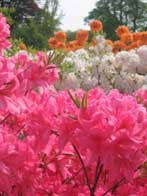Monthly Advice: June

lesley@designedgardens.co.uk
tel: 07979 888 396
June.The thing I love about June is, we still have the whole Summer to look forward to. The garden is now a wonderful place to be in the evening as the smell of barbeques wafts around and you can take a moment to enjoy your all your hard work...but of course there is plenty more work still to be done!
Lawn care Mow at least once a week, or twice for a high quality finish, with the blades low.If you haven't done so yet this year apply a summer feed to green it up. Monthly Lawncare Guide.
Pots: Planting in pots is such a versatile way to give your garden colour and interest with the advantage that plants become mobile! Now is the time to prepare your summer pots and with the vast array of summer bedding to choose from you can let your imagination run wild.
Moving Pots: One of the advantages of planting in pots is that you can move plants around to suit the season and layout of the garden. However pots can be very heavy and awkward not to mention dirty and so care should be taken. You can take the strain out of moving your pots by investing in a Pot Mover which is like a little porters trolley and will move pots up to 50kg. Pot movers can be purchased here
Pot Care: Your summer potted displays can last well into Autumn but will require a little attention. As the compost in the pot has only a limited amount of nutrients you must either add some slow release fertiliser pellets, ideally mixed into compost before you plant, or give regular liquid feeds following the manufacturers instructions. Watering is very important as pots will dry out very quickly. Don't fall into the trap of not watering your pots just because it has rained ...quite often the rain will not even find its way to the compost or will evaporate before it soaks in.
Mix some water storing granules into the compost to retain moisture. These work by absorbing water and releasing it slowly back into the compost and can save a lot of effort if you have lots of pots to water. You can buy them online here.
Planting: Sow biennials this month. These are plants such as wallflowers and forget me me nots, which produce leafy growth in the year they are sown and flower the next. The seedlings are usually planted somewhere unobtrusive in the garden ( or in a nursery bed) and then planted into borders in the autumn. You can of course grow them in pots.
Watering Tips: June can be very dry and lack of water can ruin months of hard work. Water plants everyday in a dry spell concentrating on the base of the plant. DO NOT water in bright sunlight as scorched leaves may result and much of the water will simply evaporate. Early evening is the best time to water while enjoying a relaxed walk around the garden...and in my case often accompanied by a glass of wine! In really extreme weather you may want to water early in the morning as well...probabaly best to omit the wine though in this case!
Use a hose (if permitted) with an adjustable nozzle fitted or a watering can with a rose. Fit the rose so that the holes face upwards not down, use a fine one for delicate plants and seedlings and a coarse one for established plants and shrubs. Give special attention to plants at or near the base of a wall as this will become very dry as the bricks suck up moisture. Do not let pots dry out ...if they do and the compost has 'shrunk' imerse them in a bucket of water for half and hour or so to re-hydrate.
Weeding.Hoe over your beds and borders to displace the seedlings of annual weeds. You don't need to remove them as they will die off. To further prevent weed growth mulch with bark or grass clippings. Mulch Materials.
Remove: dead flowers from rhododendrons by pinching at the base of the flower with thumb and forefinger. This will encourage more abundent flowering next year.
Pruning. Cut back clematis motana after flowering if it is getting too big and straggley or put up some simple supports such as wire or twine and train the new growth. Training the growth horizontally by winding the new shoots together will produce a neat effect when it flowers next year. Clematis alpina can be cut back hard once flowering is over.
Ponds:.Remove blanket weed (algae) from ponds. This can be done simply by twisting around a stick and pulling it out. Pile it up next to the pond before you remove it if you can to give any inhabitants that may have got caught up a chance to find their way back into the water. Plant water lillies now and aim to allow only about a third of the surface uncovered to avoid the water turning green. Aeriating plants such as canadian pondweed will also help.